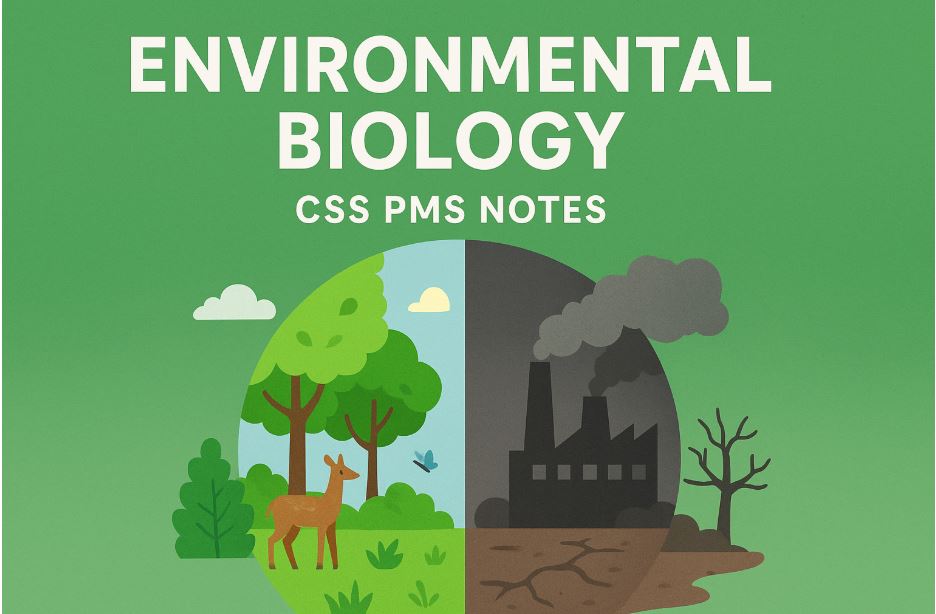Environmental Biology: Understanding the Living World and Human Impact

Introduction: Where Life Meets the Environment
Every living thing on Earth is connected. The air we breathe, the water we drink, and the soil we walk on — all are part of one huge system called the environment. When we study how living beings interact with this system, we enter the fascinating world of Environmental Biology.
This field of science helps us understand how life works within nature — and how human actions are changing it. From saving forests to fighting pollution, environmental biology explains why protecting nature is essential for our survival.
What Is Environmental Biology?
Environmental biology is the study of living organisms and their relationship with the environment. It explores how plants, animals, and microorganisms live, grow, and adapt in different surroundings.
In simple words, it shows how life depends on the environment — and how the environment depends on life. Scientists in this field combine biology, ecology, and environmental science to solve modern challenges like climate change, pollution, and biodiversity loss.
The Scope of Environmental Biology
Environmental biology covers a wide range of topics — from studying microbes in soil to understanding global climate systems. Its scope includes:
- Ecosystems and biodiversity
- Air, water, and soil quality
- Pollution control and waste management
- Energy and sustainability
- Conservation and wildlife protection
This branch of biology focuses on creating balance — making sure human progress does not destroy natural systems.
Components of the Environment
All environments are made up of two main parts: biotic and abiotic.
| Type | Description | Examples |
|---|---|---|
| Biotic | Living things | Plants, animals, fungi, bacteria |
| Abiotic | Non-living things | Air, water, sunlight, minerals |
These two components constantly interact. For example, plants (biotic) need sunlight and water (abiotic) to grow. Without this connection, life on Earth cannot exist.
Ecosystems and Biodiversity
An ecosystem is a community of living and non-living things working together. It could be a forest, an ocean, a river, or even a desert. Each ecosystem has its own biodiversity — the variety of life within it.Biodiversity keeps the planet stable. It helps regulate climate, purify air and water, and produce food. Unfortunately, human activities like deforestation and pollution are destroying biodiversity faster than nature can recover.
Human Impact on the Environment
Humans have changed Earth more than any other species. While technology and progress have improved our lives, they’ve also caused major environmental damage.
Common human impacts include:
- Pollution: Factories, vehicles, and waste pollute air, land, and water.
- Deforestation: Cutting trees for land and timber destroys animal habitats.
- Climate change: Burning fossil fuels increases greenhouse gases.
- Overpopulation: More people mean more demand for resources.
These changes affect the climate, reduce biodiversity, and weaken ecosystems.
The Role of Environmental Biology in Finding Solutions
Environmental biologists study how to reverse environmental damage.
They research the causes of problems like water contamination, deforestation, and soil erosion — and develop sustainable ways to fix them. Examples include:
- Restoring forests and coral reefs.
- Developing sustainable farming methods.
- Studying renewable energy sources.
- Protecting endangered species through conservation programs.
Environmental biology helps us understand nature scientifically — so that our solutions are effective and lasting.
Importance of Environmental Biology in Education and Careers
This field is not just for scientists — it’s for anyone who cares about the planet. Studying environmental biology helps students understand how life and the environment are linked.
Career paths include:
- Ecologist – studies how organisms interact with ecosystems.
- Environmental Analyst – measures pollution and ecosystem health.
- Conservation Scientist – protects forests, rivers, and wildlife.
- Researcher or Educator – spreads awareness and teaches sustainability.
Every country now needs environmental biologists to guide policies and restore balance to the natural world.
Climate Change and Environmental Biology
Climate change is one of the greatest challenges of our time. Environmental biology plays a crucial role in understanding how greenhouse gases, deforestation, and urbanization affect global ecosystems.
Scientists also study how species adapt to changing temperatures — and how humans can reduce carbon footprints.
Adaptation and Mitigation
- Adaptation: Adjusting to new conditions (e.g., planting drought-resistant crops).
- Mitigation: Reducing the causes (e.g., cutting carbon emissions).
Environmental biology connects both — helping society build a greener and safer future.
Global Responsibility: What Can We Do?
We all have a role in protecting the environment. Small actions make a big difference:
- Reduce, reuse, and recycle.
- Save water and energy.
- Support clean energy.
- Plant trees and protect wildlife.
Environmental biology shows that protecting the planet is not just science — it’s a shared duty of all humans.
Conclusion: The Future of Environmental Biology
Environmental biology is more than a subject — it’s a movement to save life on Earth. It teaches us that every organism, no matter how small, has a role in maintaining balance.If we protect nature, nature will protect us.
“The health of our planet is the health of humanity.” 🌿
❓ FAQs
Q1: What is environmental biology in simple words?
Environmental biology studies living things and how they interact with air, water, soil, and climate.
Q2: Why is environmental biology important?
It helps us understand human impact on ecosystems and guides solutions for a sustainable future.
Q3: What are examples of environmental biology?
Studying pollution, deforestation, water conservation, and climate change are common examples.
Q4: How does environmental biology help in climate change?
It identifies causes, predicts impacts, and finds eco-friendly ways to reduce emissions and adapt.
Q5: What careers are available in environmental biology?
Jobs include ecologist, conservationist, environmental analyst, and sustainability researcher.